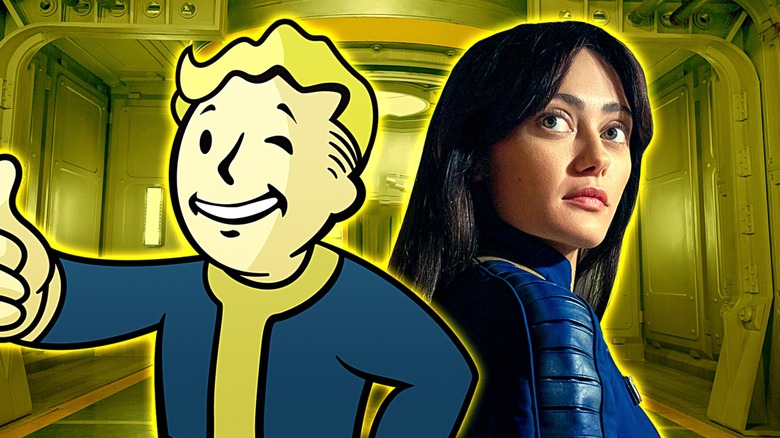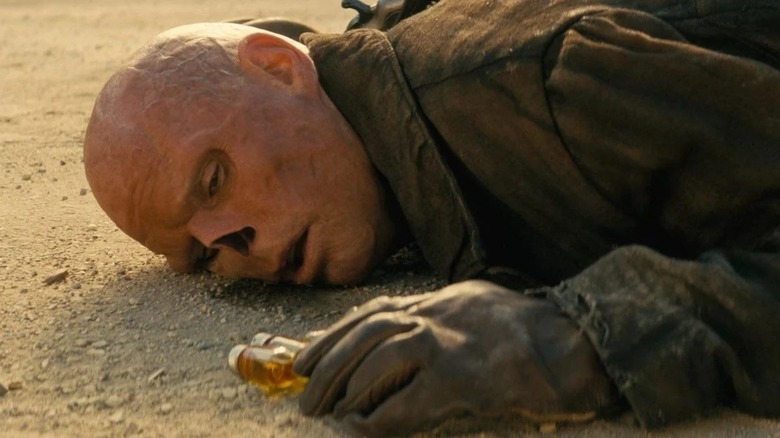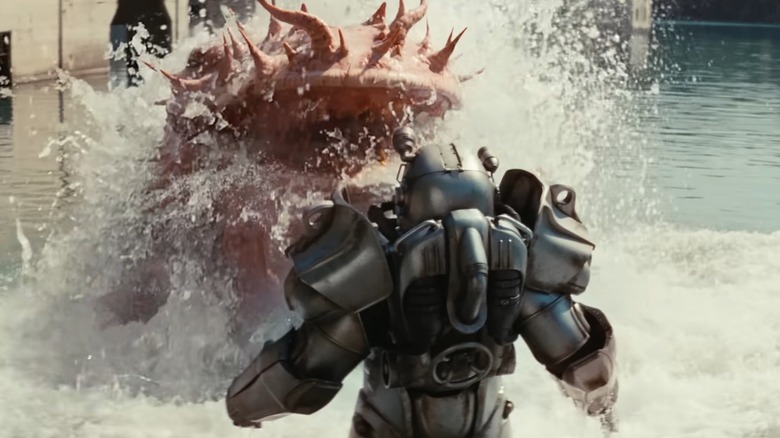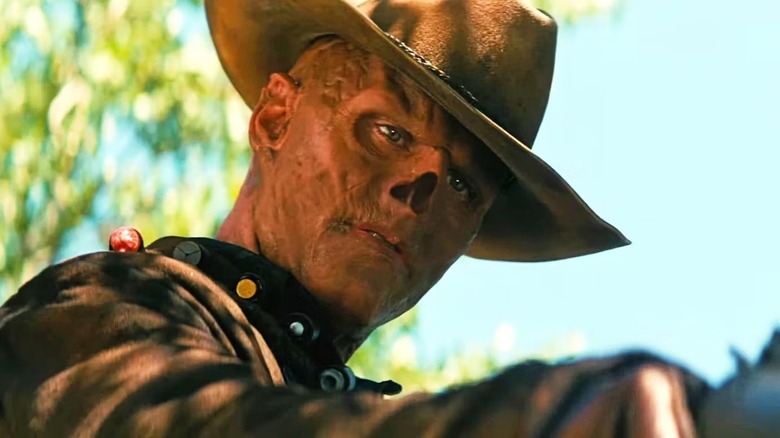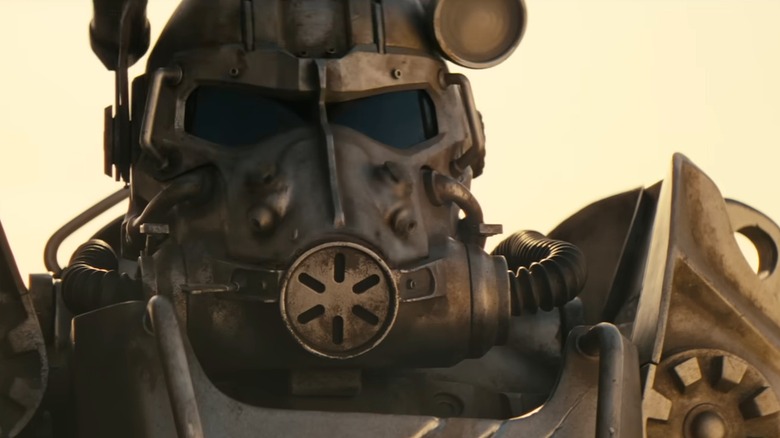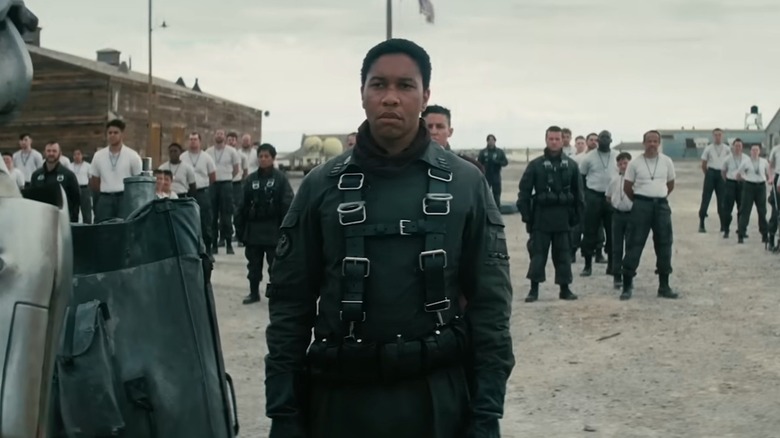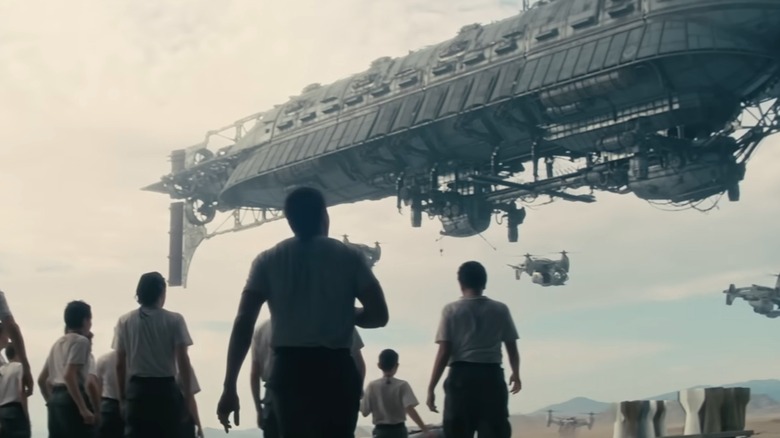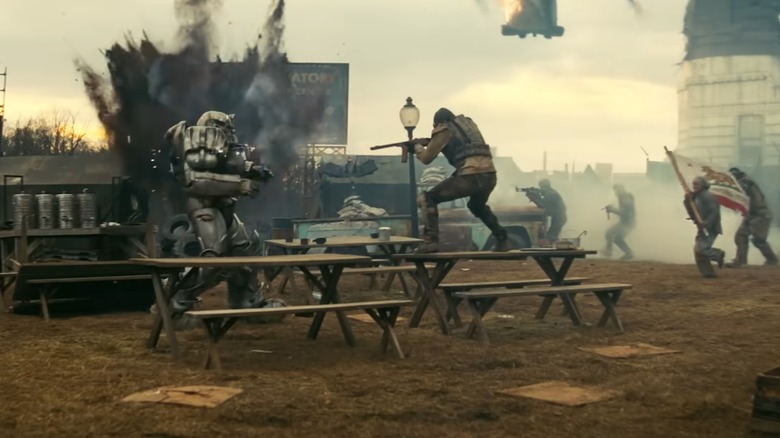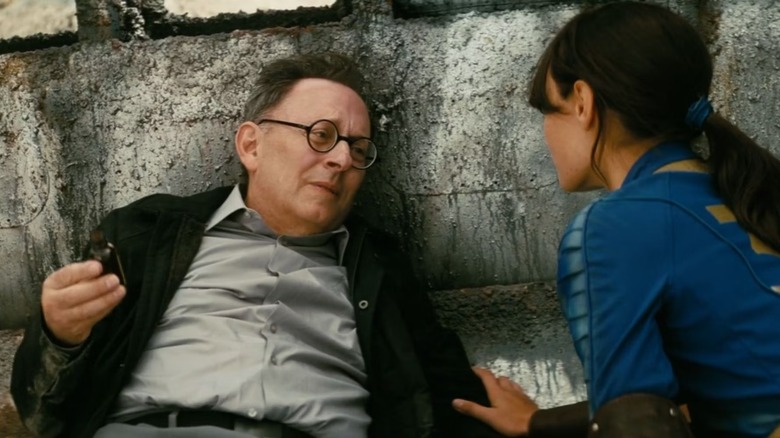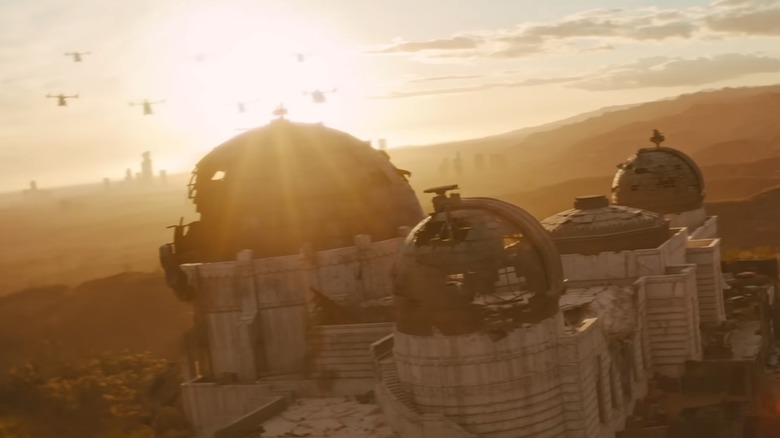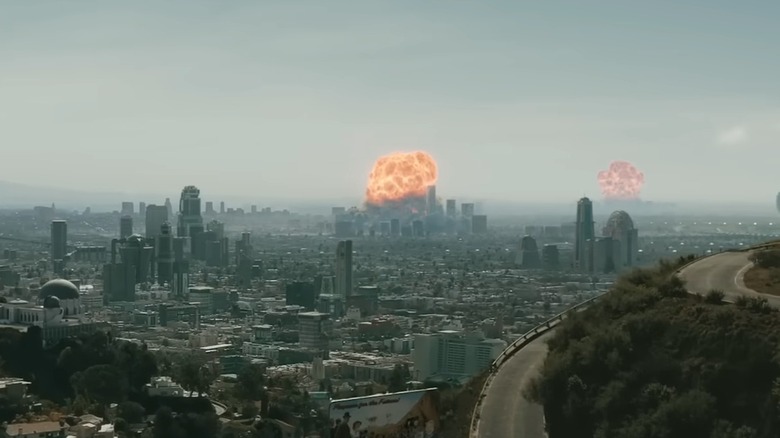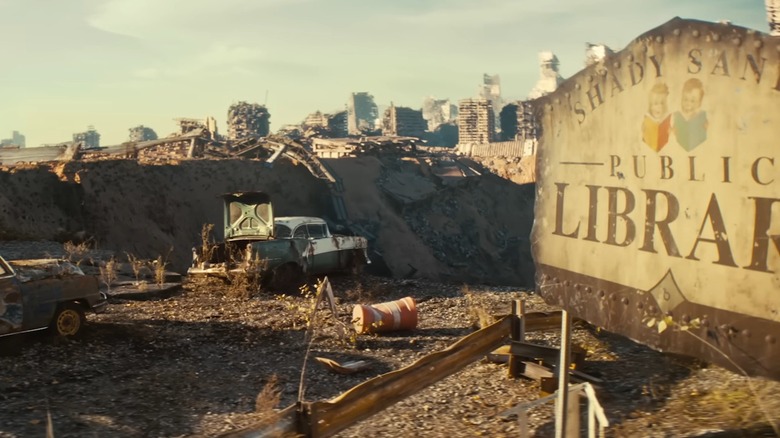11 Biggest Differences Between The Fallout Show And The Games
Even if you've never touched a "Fallout" game, the reviews say the show is still well worth watching. Critics have praised the Amazon Prime Video series for its story, visuals, and worldbuilding, with many dubbing "Fallout" one of the best video game adaptations we've ever had. The one thing that any old school "Fallout" fan is sure to notice while watching the show is that it takes the games very seriously. From the sets and props to the sound cues, the "Fallout" show accurately translates so much of what made the games so popular. "Fallout" is blowing everyone away, but that's not to say the show got everything from the games exactly right.
As a franchise, "Fallout" has a long and convoluted history. The games even have a tendency to contradict themselves, leading to all sorts of mysteries and debates for fans to sort out. The show was bound to take a few liberties, and since Amazon's series is set later in the timeline than any of the games, it was always going to bring some major changes to the franchise. It hasn't completely rewritten the story from the games, but it's added plenty of new lore and recontextualized some old debates. Let's dig into the biggest changes the "Fallout" show made from the games.
The Fallout show loves serums
You can't watch "Fallout" without picking up on the fact that the show is oddly into serums. The Ghoul (Walton Goggins) spends an episode selling Lucy (Ella Purnell) to organ harvesters at a Super Duper Mart to try and get vials of a serum that prevents ghouls from going feral. Then you've got the Snake Oil Salesmen character, who is all about claiming to create mystical serums — at least one of his concoctions actually works, as it gave Thaddeus (Johnny Pemberton) the ability to heal from any injury. It might also end up transforming Thaddeus into a ghoul, but that's beside the point.
In the "Fallout" games, there are plenty of mysterious drugs and suspicious chemical cocktails, but neither of these particular serums exist. The anti-feral ghoul serum seems like it will be a driving force in the next season of "Fallout," and it's been at the center of a lot of online chatter, with fans trying to figure it out. One Redditor has predicted that the serum is "only required for ghouls that have started going feral already," while another added, "If all ghouls need to take it then it totally breaks lore. Gob didn't have to take it, Charon didn't take it, in fact no ghouls in the games mentioned it."
A different breed of Gulpers
The Gulper is by far the weirdest irradiated creature that the "Fallout" show puts in the spotlight. The ones seen in the Amazon series look a bit like giant axolotls, if axolotls had human fingers covering the inside of their mouths. They're shown to be absolutely ferocious, but don't worry too much if one swallows you whole — they digest food slowly, so maybe your friends will have time to come save you. These terrifying creatures undoubtedly make for great TV, but the ones in the show aren't the same as the ones gamers are familiar with.
Gulpers were introduced in the "Fallout 4" DLC "Far Harbor," and since then they've also appeared in "Fallout 76." The ones seen in the games more closely resemble giant hellbender salamanders than axolotls, with a dark, almost reptilian design. Axolotls, meanwhile, have a rounder head and a pink skin tone, like the Gulper from the show. The differing appearance is down to the fact that these groups of Gulpers exist on opposite sides of the country.
In the games, players encounter Gulpers on the East Coast, but in the show, they've taken root in the flooded area around what used to be Hollywood Boulevard. According to Ben Carnow, who designed the original Gulper "on a very accelerated schedule for an internal game jam," they're basically cousins. "It would have been amazing to see my design in the show, but I honestly love when there are regional differences to creatures," he said on X (formerly Twitter).
Fallout's changing rules for ghouls
The "Fallout" show plays fast and loose with its rules for ghouls. It tells us that at least some ghouls need a special serum to prevent themselves from going feral, and it also shows us that ghouls can apparently live for centuries without dying. When it comes to how ghouls manage to stay alive for so long, the show has less to say, but it certainly gives us the impression that ghouls are practically immortal.
In the "Fallout" games, you can blast a ghoul to bits just as easily as you can a human raider. In the show, however, some ghouls seem to be able to rapidly heal from any physical wound. The Ghoul himself gets shot multiple times in Filly, but not a single bullet manages to slow him down. Later, when Maximus (Aaron Moten) sees Thaddeus heal from an arrow wound in the neck, he says that he thinks Thaddeus is a ghoul.
Maximus' statement makes it seem as though a ghoul's healing power is common knowledge, but other scenes contradict this: Several feral ghouls are killed with run-of-the-mill guns at the Super Duper Mart, for example. Could the show be trying to make a subtle reference to the fact that some special ghouls in the "Fallout" games (known as Glowing Ones) can heal themselves and other feral ghouls with their high levels of radiation? Even if we assume that to be the case, the series still changes the rules by giving any old ghoul that power.
The show's power armor isn't built the same
Almost nothing is as emblematic of the "Fallout" universe as power armor. The box art of the very first game put a power armor helmet front and center, and ever since then, power armor has been one of the most sought after items in the series. Sometimes, like in "Fallout 3," power armor is just the best way to defend yourself out in the wasteland, but in games like "Fallout 4," for example, power armor transforms you into a mechanized tank that can fly across the wastes with ease.
Just like in the games, power armor has an important role to play in the "Fallout" series, but there are some notable differences in how it works. We get to see Maximus fly around in his stolen power armor, but instead of having a jetpack, his armor uses wrist-mounted propulsion à la Iron Man. Also, the power armor that the Brotherhood of Steel uses in the show has a major flaw that doesn't exist in the games: There's a seam in the armor that the Ghoul uses to single-handedly take down an entire squadron of Brotherhood Knights.
Maximus' Brotherhood chapter is bizarrely aggressive
The Brotherhood of Steel is not the most consistent "Fallout" faction, with its influence and goals varying somewhat from game to game. Initially, their main purpose was to collect and hoard technology, understandably believing that humankind could not be trusted with it. As the Brotherhood stretched its reach across the remains of the United States, different chapters started setting their own priorities. Some became more concerned with protecting the people of the wasteland, while others came to obsess over "purifying" the land by killing all mutated creatures like ghouls and super mutants.
Maximus' chapter of the Brotherhood in the "Fallout" show is unlike any that we've seen before. They care about collecting pre-war technology, but they also seem to be dedicated to finding wasteland orphans and inducting them into their order. Elder Cleric Quintus (Michael Cristofer) says that the Brotherhood has lost its way, and he envisions a future where the Brotherhood rules over the wasteland with a power-armored fist. That's a much more aggressive and authoritarian stance than any Brotherhood Elder in the games has ever taken, and it might explain why members of Maximus' chapter, like Knight Titus (Michael Rapaport), are so cruel. Clearly the show is taking the Brotherhood in a bit of a new direction, one that will put the faction at the center of more conflict.
The Brotherhood of Steel is becoming a united front
As the Brotherhood of Steel spread out across the country, its chapters slowly stopped communicating with each other. Aside from radio there's no good way to communicate across long distances in the wasteland, so over time the Brotherhood chapters on the East Coast and the West Coast became mostly separate entities. In "Fallout 4," Elder Arthur Maxson rose to power on the East Coast after gaining the support of the West Coast elders, but he still primarily pursued his own goals.
The "Fallout" show seems to be setting the stage for a more unified Brotherhood of Steel. In the very first episode we see a giant Brotherhood airship approach Maximus' base. The ship is the Prydwen, which was previously seen in "Fallout 4" under the control of Elder Maxson. Apparently, some of the Commonwealth Brotherhood members have made their way back to California. What's even more interesting is that before the show was released, the airship was referred to as the Caswennan. If the showrunners thought the Prydwen's appearance was a secret worth keeping, then it seems more likely that it's going to have a bigger role to play in the future.
What happened to the NCR?
The New California Republic was the first organized government that formed after the bombs dropped, and it made its capital Shady Sands, one of the first post-war cities ever built. The NCR had a huge role to play in "Fallout 2" and "Fallout: New Vegas," and in the latter we learned that by 2281 the NCR had grown to a full-fledged civilization with over 700,000 citizens. In the most controversial change introduced by the "Fallout" show, it turns out that shortly after the events of "Fallout: New Vegas," Shady Sands was wiped off the face of the planet by nukes. "The bombs fall just after the events of 'New Vegas,'" Bethesda's Todd Howard told IGN, confirming that the fall of Shady Sands is indeed canon.
The survivors of this devastating event have since scattered to various other cities and settlements, and so far it seems like only remnants of the NCR remain. It's a bit of a shock, though you could argue that the games set this change up to a certain extent: In "Fallout: New Vegas," we learn that the NCR is facing some instability because it expanded too quickly. It's struggling to manage the needs of its citizens while also keeping the worst of the wasteland at bay. The writing was on the wall, but the show's surprise revelation really created waves in the "Fallout" fandom.
The Enclave still exists
In the "Fallout" universe, the Enclave is a group of former government officials and wealthy elites who seek to restore the best and worst parts of pre-war America. More often than not, Enclave members show up as villains in various games, and in "Fallout 3" the organization was supposedly defeated forever, becoming a spent power. However, much like radroaches, it's apparently impossible to keep them down. The "Fallout" show has resurrected the Enclave, with one member playing a big role in the story.
In the first episode of the Amazon series, we learn that Maximus and Titus are hunting for someone from the Enclave, and in Episode 2, we're taken to an Enclave facility, where Dr. Siggi Wilzig (Michael Emerson) is developing a mysterious device. Wilzig defects from the Enclave and escapes into the Wilds after an Enclave administrator realizes that he's carried out unauthorized cold fusion research, and this is what triggers a manhunt by the Brotherhood of Steel. We don't learn much about what's left of the Enclave over the course of the season, but, despite the group being on the fringes of the story, its importance in the grand picture is implied.
The West Coast has taken several backward steps
Much like the NCR itself, the West Coast as a whole seems to be in rough shape in the "Fallout" show. The status of the wasteland probably doesn't seem strange to anyone who's getting their first dose of "Fallout" from the Amazon series. After all, shouldn't a show about life after a nuclear apocalypse be, well, apocalyptic? Well, yes, but for anyone who's been keeping up with the past several decades of "Fallout" lore, the West Coast shown in the series couldn't look stranger.
Up until this point, most of California, parts of Oregon, and even bits of territory in Nevada were under the control of the NCR. We're talking full cities, paved roads, even taxes. Life in this part of the country looked a lot more civilized and a lot less survivalist than what we see in the "Fallout" show. Instead of functioning cities, we see a little settlement like Filly. Instead of paved roads, we see dangerous, unpatrolled wasteland. It's safe to say that the nuclear strike on Shady Sands also affected the surrounding area in a big way.
Vault-Tec was prepared to drop the bombs
For as long as the "Fallout" games have existed, fans have debated about who dropped the bombs first. The global thermonuclear war known as the Great War in "Fallout" lore was the result of a decades-long conflict between the United States and China. Readable in-game records from the American side state that the Chinese launched their strike first, but nothing is known for certain. The TV show muddied the waters even further by suggesting that Vault-Tec may have actually played an active role in starting the Great War.
In the season finale, Cooper Howard is spying on a Vault-Tec board meeting. He hears his wife (a high-ranking exec in the company) pitch the concept of vaults to other bigwig industry barons, and her main selling point is that Vault-Tec can guarantee its products will be put to use by dropping the very first nuke. It appears as though the company was entirely prepared to sacrifice the world in exchange for profit.
This doesn't necessarily mean that Vault-Tec nuked the whole United States, but it confirms that the company had the means and the motivation to do so, and that's a line that wasn't crossed in the games. Redditor u/Savvyjack54 has put forward the argument that Vault-Tec actually hit China, knowing full well a response would come. "As the show mentions, the top levels of government, president, Enclave, Vault-Tec, seemed to know about the bombs being dropped," they wrote. "I find it entirely possible that Vault-Tec dropped a bomb on the Chinese mainland."
Post-war nukes are now a thing
If you thought that Vault-Tec having access to nukes before the war was a wild reveal, hopefully you were sitting down when, just a few minutes later, the show confirmed that Overseer Hank MacLean (Kyle MacLachlan) somehow managed to drop a nuke on Shady Sands. These revelations come rapidly at the end of "Fallout" Season 1, but to summarize: Hank was a Vault-Tec executive, and he bombed Shady Sands to "protect" Vault-Tec's mission. Presumably, the Overseers from Vault 33 had access to at least one nuke, and Betty Pearson (Leslie Uggams) all but says she helped Hank launch the bomb.
Rather ironically, nukes aren't all that prevalent in the "Fallout" games. There are plenty of big bombs, and even an array of miniature nukes that just about everyone apparently has access to, but the kind of nukes that caused the Great War didn't really survive it. It appears as though most of them were launched during the devastating exchange that brought down civilization, with one of the few remaining bombs lying undetonated in the town of Megaton. Now that the show has opened the door to post-war nukes, we're always going to be wondering how many remain and who else has the ability to launch them.
